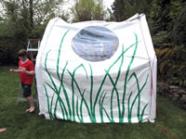Sustainable innovative play tent
For her year 13 soft materials technology project, Zoe from Kaikorai Valley College created a custom outdoor play tent for her younger sister, using sustainable materials and construction techniques, and strong artistic elements in its design. Her project won her an Outstanding New Zealand Scholarship award.
Issue
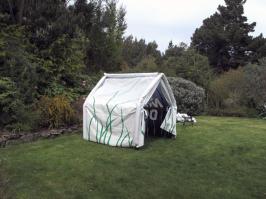
Tent 1.
Zoe's mother, Elizabeth, was concerned with the time that younger sister Rachel spent indoors watching TV, and wanted to encourage Rachel to play independently outside. Zoe realised that rainy days and a lack of interest were setbacks for this so decided to create a personalised tent that would meet the specific requirements of both her mother and daughter.
Zoe knew this issue had excellent potential for a soft materials technology project but could immediately see a problem. As Zoe had two stakeholders for this project, early consultation with her mother and sister were essential to help create a set of specifications as she developed her brief. She divided the initial specifications into three groups:
- Functional – The tent needed to be weatherproof, durable, easy to put on and remove, as well as being entertaining for Rachel and staying within a $1,000 budget.
- Aesthetic – The tent had to fit its location, be visually interesting "like an art piece", be colourful and include green and some patterns. It should impress Rachel's friends.
- Ethical – The tent needs to be sustainable and environmentally friendly in its materials and construction process.
Research
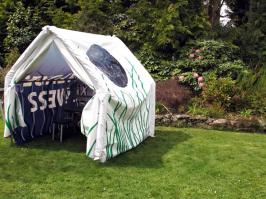
Tent 2.
Zoe began researching these aspects as well as interviewing experts, technologists, and artists. She first established the basic requirements her tent would need for its construction, as well as the pros and cons of standard tent materials such as nylon and canvas. Zoe found sourcing a material that was both functional and sustainable a major concern: nylon was light but not strong and prone to rot, and canvas was strong but heavy, and both failed to meet the sustainable aspects of the project's brief.
Her solution came from an unexpected source. While talking to a practising artist about creating the tent as an exhibition art space, Zoe noticed that his bag was made from recycled PVC billboards – a waterproof and durable outdoor material.
The old billboards were a perfect solution – made to meet all the necessary functions, but the recycling of them would mean that my practice was sustainable, and the tent would remain fit for purpose.
Zoe
Consultation with her sister Rachel and her friends – who served as wider stakeholders – led to another innovative solution:
They really wanted the top bars of the jungle gym to remain uncovered so they could use them while the tent is on the frame, so I included this as a specification.
Zoe
Zoe's previous research into existing tent designs provided the solution – air beams, a system used on larger tents where inflatable tubing creates the structure of the tent.
Air beams would not only keep the tent above the top bars, but also make the tent easily removable – the beams would hold it in shape and place so you could just pull it on from the front and off from the back. It also gave me the option of creating a tent removed from the limited shape of the bars – something possibly more architectural, or natural for the location.
Zoe
Research into the history of tents in various cultures also gave Zoe the idea of incorporating cultural aspects into the interior decorations of the tent.
Construction
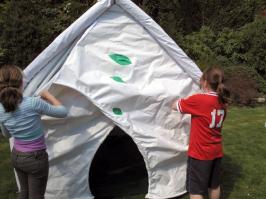
Tent 4.
Zoe revised her brief and was now ready to begin construction, but still needed advice on some technical aspects. Zoe contacted Covermarq, a local company that specialised in creating tents, marquees, and other covers from canvas, nylon and PVC, who advised her on their patternmaking process and also helped with the installation of the air beams.
Zoe created several models on a small scale to test design concepts and get the go-ahead from her stakeholders, working first in paper, then cotton, and finally in the billboard fabric in order to test her construction techniques.
Using the same process as Covermarq, she transferred the measurements from her designs directly to the fabric using rulers, rather than using a paper pattern.
The drawings were so precise and simple that I did not need special paper patterns. Besides, a paper pattern would take around 10 metres of paper which wasn't a sustainable practice.
Zoe
Zoe then worked for several weeks constructing the tent using the industrial sewing machines available at the school. This part of the project took a massive amount of determination from Zoe.
The construction was difficult and frustrating. The sheer volume, weight and size of it was so hard to work with, it could take an hour just to sew a seam well.
Zoe
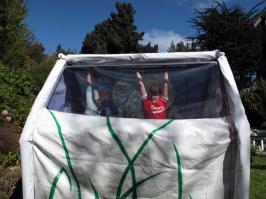
Tent 5.
Zoe explains that while most of this part of the process was straightforward hard work, there were a few hurdles.
There were a few minor problems such as the seams of the sleeves being too thick to sew together after topstitching – so I widened the sleeve a little and stitched in the gutter beside the sleeve which solved it.
Zoe

Tent 6.
Once the tent was completed, Zoe revealed her project with an exhibition for the Year 7 students from her school.
I thought that the Year 7s were suitable candidates to have see my tent as they are the same age as Rachel, and could help evaluate such things as their level of interest in it and the viability of the tent idea as a product.
Zoe
Feedback for the tent has been extremely positive and Zoe received an Outstanding New Zealand Scholarship award.

